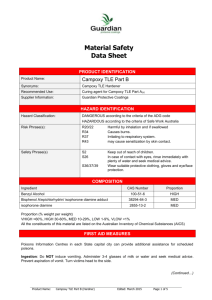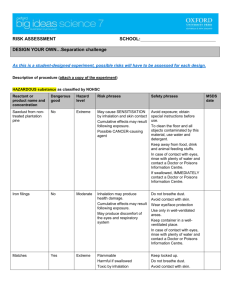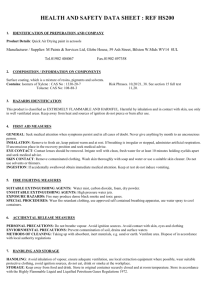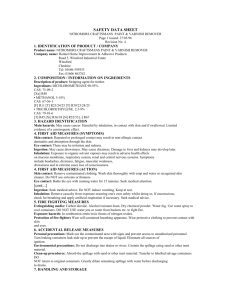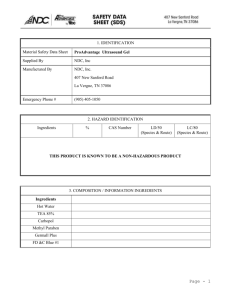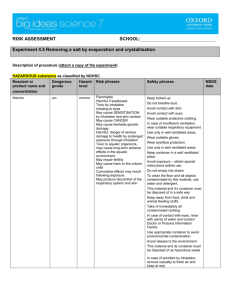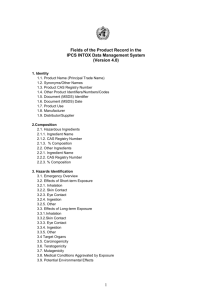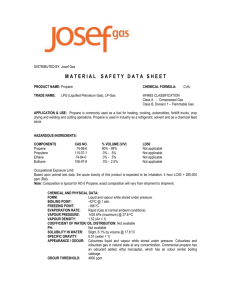Section 1 - Guardian Protective Coatings
advertisement
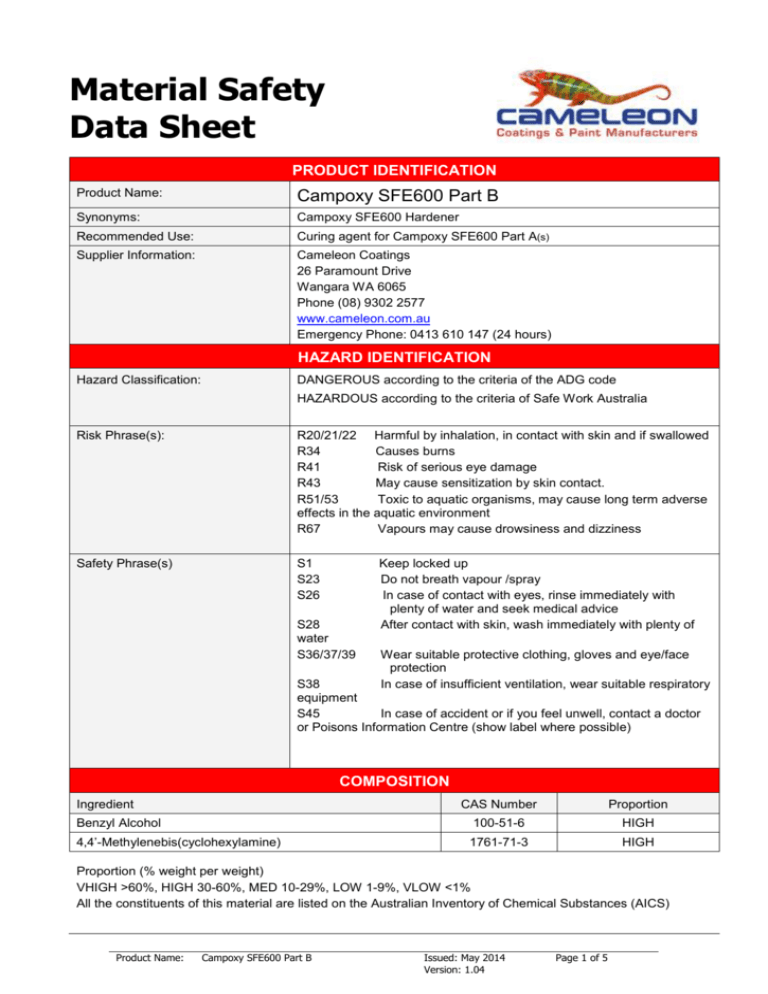
Material Safety Data Sheet PRODUCT IDENTIFICATION Product Name: Campoxy SFE600 Part B Synonyms: Campoxy SFE600 Hardener Recommended Use: Curing agent for Campoxy SFE600 Part A(s) Supplier Information: Cameleon Coatings 26 Paramount Drive Wangara WA 6065 Phone (08) 9302 2577 www.cameleon.com.au Emergency Phone: 0413 610 147 (24 hours) HAZARD IDENTIFICATION Hazard Classification: DANGEROUS according to the criteria of the ADG code HAZARDOUS according to the criteria of Safe Work Australia Risk Phrase(s): R20/21/22 Harmful by inhalation, in contact with skin and if swallowed R34 Causes burns R41 Risk of serious eye damage R43 May cause sensitization by skin contact. R51/53 Toxic to aquatic organisms, may cause long term adverse effects in the aquatic environment R67 Vapours may cause drowsiness and dizziness Safety Phrase(s) S1 S23 S26 S28 water S36/37/39 Keep locked up Do not breath vapour /spray In case of contact with eyes, rinse immediately with plenty of water and seek medical advice After contact with skin, wash immediately with plenty of Wear suitable protective clothing, gloves and eye/face protection In case of insufficient ventilation, wear suitable respiratory S38 equipment S45 In case of accident or if you feel unwell, contact a doctor or Poisons Information Centre (show label where possible) COMPOSITION Ingredient CAS Number Proportion Benzyl Alcohol 100-51-6 HIGH 4,4’-Methylenebis(cyclohexylamine) 1761-71-3 HIGH Proportion (% weight per weight) VHIGH >60%, HIGH 30-60%, MED 10-29%, LOW 1-9%, VLOW <1% All the constituents of this material are listed on the Australian Inventory of Chemical Substances (AICS) Product Name: Campoxy SFE600 Part B Issued: May 2014 Version: 1.04 Page 1 of 5 Material Safety Data Sheet FIRST AID MEASURES Poisons Information Centres in each State capital city can provide additional assistance for scheduled poisons. Ingestion: Do NOT induce vomiting. Never give anything by mouth to an unconscious person. Prevent aspiration of vomit. Rinse mouth thoroughly with water and contact a Poisons Information Centre. Urgent hospital treatment is likely to be needed. Eye Contact: Immediately irrigate with copious quantities of water for at least 1 hour with eyelids held open. Take care not to rinse contaminated water into the unaffected eye or onto the face. Seek medical advice. Take special care if the person is wearing contact lenses. Skin Contact: Immediately wash contaminated skin with lukewarm, gently flowing water for at least 1 hour. DO NOT INTERRUPT FLUSHING. Remove contaminated clothing and wash before re-use. Destroy contaminated leather apparel. Strongly basic ingredients tend to penetrate the skin and so need longer rinsing than other substances. Seek Medical Attention. Inhalation: If breathing has stopped or is laboured, give assisted respiration. Supplemental oxygen may be indicated. If the heart has stopped, trained personnel should begin cardiopulmonary resuscitation immediately. Move to fresh air. Most important symptoms/effect, acute and delayed: Aggravated medical conditions: Eye disease, skin disorders and allergies. Asthma. Neurological disorders. Liver disorders. FIRE FIGHTING MEASURES Specific Hazards: May generate toxic, irritating or flammable combustion products. Contact of liquid with skin must be prevented. Sudden reaction and fire may result if product is mixed with an oxidising agent. Incomplete combustion may form carbon monoxide. May generate ammonia gas. May generate toxic nitrogen oxide gases. Fire Fighting Advice: On burning this product may emit toxic nitrogen oxide gases. May generate ammonia gas. Personnel in vicinity and down-wind should be evacuated. Fire fighters to wear self-contained breathing apparatus, butyl rubber boots, gloves, and body suit if risk of exposure to vapour or decomposition products. Suitable Extinguishing Media: Alcohol-resistant foam, carbon dioxide, dry chemical, dry sand, limestone powder ACCIDENTAL RELEASE MEASURES Clear area of all unprotected personnel. Remove all possible sources of ignition. Product is slippery when spilt. Avoid accidents and clean up immediately. Wear protective equipment to prevent skin, eye contamination or inhalation of vapours. Use self-contained breathing apparatus and chemical protective clothing. Evacuate personnel to safe areas, Contain immediately – prevent run-off into drains and waterways. Use absorbent (soil, sand, or other inert material). Collect and seal in properly labelled containers for disposal per local regulations. If contamination of sewers or waterways has occurred advise the local emergency services. Product Name: Campoxy SFE600 Part B Issued: May 2014 Version: 1.04 Page 2 of 5 Material Safety Data Sheet HANDLING AND STORAGE Storage: Store in a cool, dry, well ventilated area. Keep away from acids and oxidisers. Do not store in reactive steel containers. This material is Harmful and a Scheduled Poison S5. It must be stored, maintained and used in accordance with relevant regulations. Use only in well ventilated areas. Avoid breathing vapours and aerosols. Avoid contact with skin and eyes. Use personal protective equipment. When using, do not eat, drink or smoke. EXPOSURE CONTROLS / PERSONAL PROTECTION National Exposure Limits. No exposure standards have been set for this product or constituents Engineering Controls: Ensure adequate ventilation; keep containers closed when not in use. Personal Protective Equipment: Overalls, Safety Shoes, Chemical Goggles, and Gloves. Avoid skin and eye contact, and inhalation of vapour. Wear overalls, chemical goggles and impervious gloves. Uses with adequate ventilation – if inhalation risk exists then wear an organic vapour / particulate respirator meeting the requirements of AS/NZS 1715 and AS/NZS 1716. Always wash hands before smoking, eating, drinking, or using the toilet. Wash contaminated clothing and other protective equipment before storage or re-use. PHYSICAL PROPERTIES Appearance: Colourless mobile liquid Solubility: <1% Odour: Ammoniacal Density @ 20°C: 1.03 kg/lt pH: Alkaline Flash point & Method: Vapour Pressure 20°C (mm Hg): <10.34 Upper Explosive Limit (UEL): NAV NAV Lower Explosive Limit (LEL): NAV Ignition Temperature °C: NAV Vapour Density (Air = 1) Initial Boiling Point °C: ~207°C Freezing Point °C: NAV ~112°C (Abel) Percent Volatiles (by weight): 0% NAP = Not Applicable, NAV = Not Available STABILITY AND REACTIVITY Stability: Product is stable; however, avoid contact with acids, oxidising agents, reactive metals, Sodium or Calcium Hypochlorite. Product will slowly corrode copper, aluminium, zinc and galvanised surfaces. Reactive with hydroxyl compounds. Hazardous Decomposition Products: Nitrogen Oxide can react with water vapours to form corrosive nitric acid. Oxides of carbon and nitrogen in a fire. Ammonia when heated. Irritating and toxic fumes at elevated temperatures. Nitric acid in a fire. Aldehydes. The oxides of nitrogen gases (except nitrous oxide) emitted on decomposition are highly toxic. Reaction with peroxides may result in violent decomposition of peroxide possibly creating an explosion. Product Name: Campoxy SFE600 Part B Issued: May 2014 Version: 1.04 Page 3 of 5 Material Safety Data Sheet TOXICOLOGICAL INFORMATION Main Symptoms: No adverse health effects are expected if the product is handled in accordance with this Material Safety Datasheet, and the product label. Symptoms that may arise if this product is mishandled are: Ingestion: Swallowing can result in severe burns of the mouth and throat, as well as danger of perforation of the stomach and oesophagus. If the victim is uncoordinated, there is a greater likelihood of vomit entering the lungs and causing serious complications. Eye Contact: Product vapour in low concentrations can cause lacrimation, conjunctivitis, and corneal edema when absorbed into the tissue of the eye from the atmosphere. Burns of the eye may cause blindness. Skin Contact: Causes skin burns. Product is absorbed through the skin and may cause nausea, headache, dizziness, confusion, breathing difficulties. Inhalation: Harmful if inhaled and may cause delayed lung injury. Risk of serious damage to the lungs by inhalation. Inhalation of aerosol may cause irritation to the upper respiratory tract. May cause central nervous system effects such as headache, nausea, dizziness, confusion, breathing difficulties. Severe cases of overexposure can result in respiratory failure. Long Term Effects: Un-protected repeated and/or prolonged exposure may cause allergic reaction/sensitization. Repeated and/or prolonged exposure may result in: adverse respiratory effects (such as cough, tightness of chest or shortness of breath); adverse skin effects (such as defatting, rash or irritation). Effects from inhalation of vapours may be delayed. Dryness of nasal passages may be experienced when material is inhaled over a long period of time. Repeated and/or prolonged exposure to low concentrations of vapour may cause sore throat (which is transient). Acute Toxicity / Chronic Toxicity: Oral LD50(Rat): >2000 mg/kg Dermal LD50(Rabbit): >2110 mg/kg ECOLOGICAL INFORMATION Toxic to aquatic organisms. May cause long term adverse effects in the aquatic environment DISPOSAL CONSIDERATIONS This product may be recycled if unused, or if it has been contaminated it may be possible to separate the contamination in some way. Only if neither of these options is suitable, consider landfill, but we recommend that the product be neutralised in a controlled manner before disposal. Disposal of empty paint containers via domestic recycling programs may differ between local authorities. Check with your local council first. TRANSPORT INFORMATION Classified as Dangerous Goods by the criteria of the Australian Dangerous Goods Code (ADG Code) for transport by road or rail. UN Number: 3066 HAZCHEM: 2X UN Proper Shipping Name: PAINT RELATED MATERIAL Packaging Group: III Class and Sub Risk: 8 Corrosive Product Name: Campoxy SFE600 Part B Issued: May 2014 Version: 1.04 Page 4 of 5 Material Safety Data Sheet REGULATORY INFORMATION Hazardous according to Worksafe Australia. Hazard Category: Hazard Category: Harmful, corrosive, Dangerous for the environment C Corrosive R-phrase(s): R20/21/22 R34 R41 R43 R51/53 R67 Harmful by inhalation, in contact with skin and if swallowed Causes burns Risk of serious eye damage May cause sensitization by skin contact. Toxic to aquatic organisms, may cause long term adverse effects in the aquatic environment Vapours may cause drowsiness and dizziness S- phrase(s): S1 Keep locked up S23 Do not breath vapour /spray S26 In case of contact with eyes, rinse immediately with plenty of water and seek medical advice S28 After contact with skin, wash immediately with plenty of water S36/37/39 Wear suitable protective clothing, gloves and eye/face protection S38 In case of insufficient ventilation, wear suitable respiratory equipment S45 In case of accident or if you feel unwell, contact a doctor or Poisons Information Centre (show label where possible) Poison Schedule : S5 OTHER INFORMATION Literary References: (1) IMCD MSDS issued April 2012 General: Material Safety Data Sheets are updated frequently. Please ensure that you have a current copy. This MSDS summarises at the date of issue our best knowledge of the health and safety hazard information of the product, and in particular, how to safely handle and use the product in the work-place. Since Cameleon Coatings cannot anticipate or control the conditions under which this product may be used or handled, each user must, prior to using or handling this product, review this MSDS in the context of how the user intends to handle and use the product in the workplace. If clarification or further information is required to ensure that an appropriate assessment can be made, the user should contact this company. Our responsibility for product as sold is subject to our standard terms and conditions, a copy of which is sent to our customers, and is also available from the company upon request. Product Name: Campoxy SFE600 Part B Issued: May 2014 Version: 1.04 Page 5 of 5
